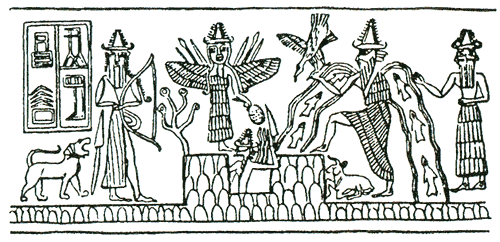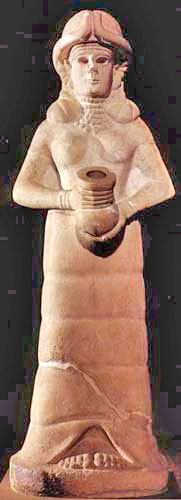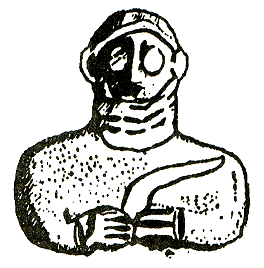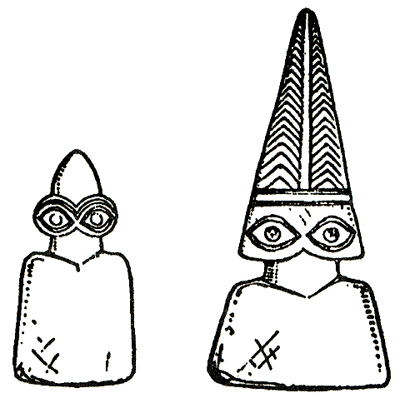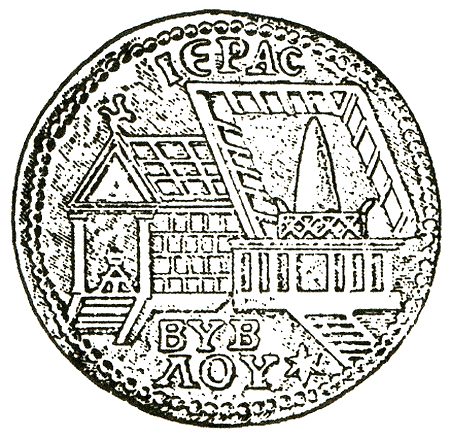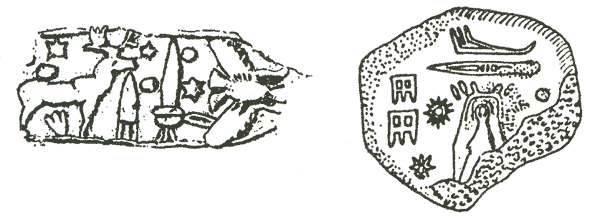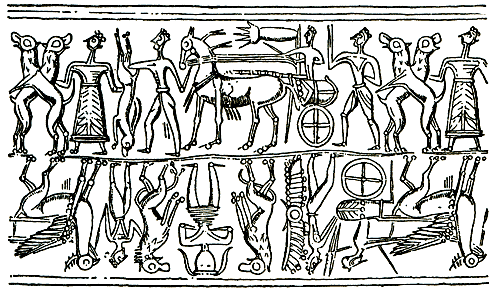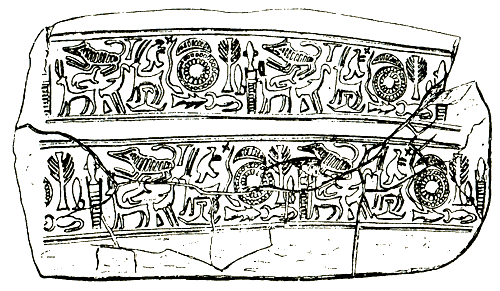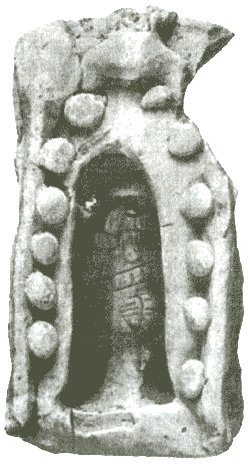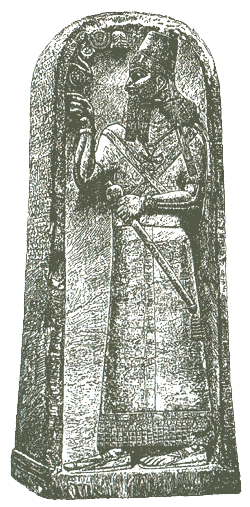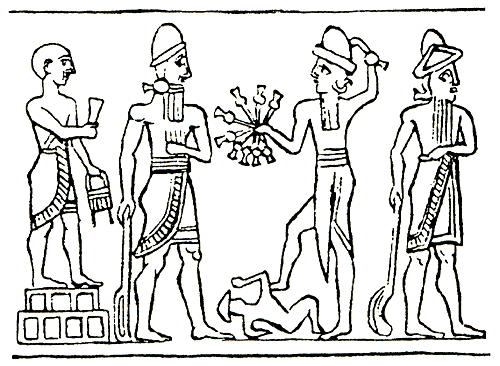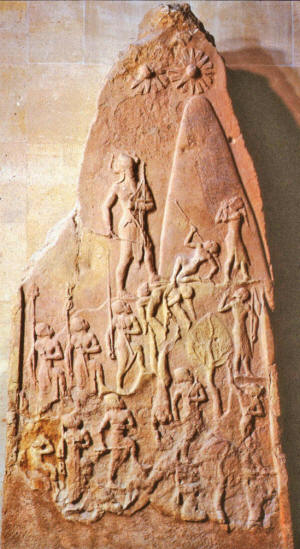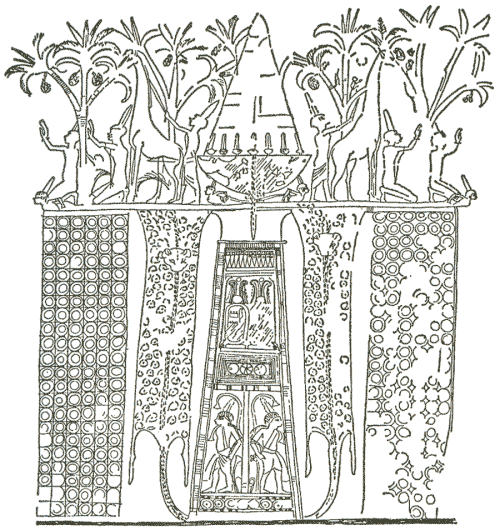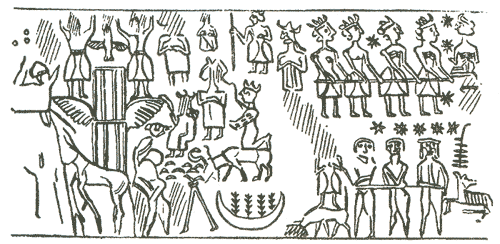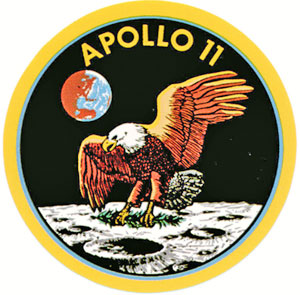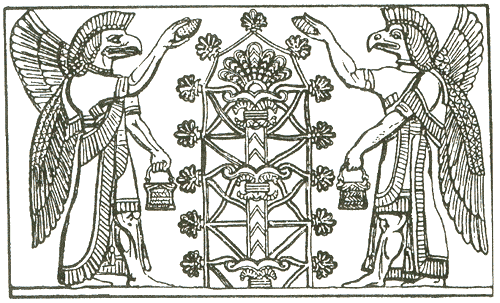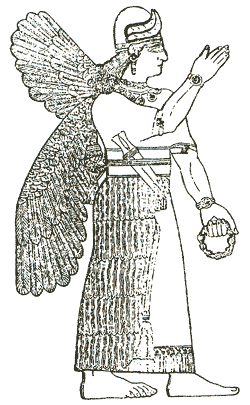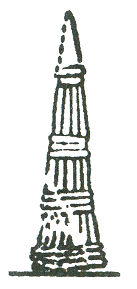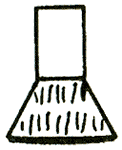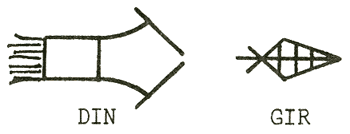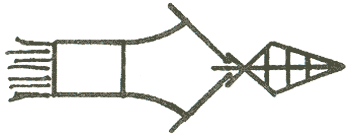|
Inanna, here described as roaming the heavens over many lands that lie far apart - feats possible only by flying - herself spoke on another occasion of her flying.
In a text which S. Langdon (in Revue d'Assyriologie et d'Archeologie Orientale) named "A Classical Liturgy to Innini," the goddess laments her expulsion from her city. Acting on the instructions of Enlil, an emissary, who "brought to me the word of Heaven," entered her throne room, "his unwashed hands put on me," and, after other indignities,
Such a capability, by Inanna as well as the other major gods, was often indicated by the ancient artists by depicting the gods - anthropomorphic in all other respects, as we have seen - with wings.
The wings, as can be seen from numerous depictions, were not part of the body - not natural wings - but rather a decorative attachment to the god's clothing.
Inanna/Ishtar, whose far-flung travels are mentioned in many ancient
texts, commuted between her initial distant domain in Aratta and her
coveted abode in Uruk. She called upon Enki in Eridu and Enlil in
Nippur, and visited
The journey was the subject not only of epic tales but also of artistic depictions on cylinder seals - the latter showing the goddess with wings, to stress the fact that she flew over from Sumer to the Lower World.
The texts dealing with this hazardous journey describe how Inanna very meticulously put on herself seven objects prior to the start of the voyage, and how she had to give them up as she passed through the seven gates leading to her sister's abode.
Seven such objects are also mentioned in other texts dealing with Inanna's skyborne travels:
Though no one has as yet been able to explain the nature and significance of these seven objects, we feel that the answer has long been available.
Excavating the Assyrian capital Assur from 1903 to 1914, Walter Andrae and his colleagues found in the Temple of Ishtar a battered statue of the goddess showing her with various "contraptions" attached to her chest and back.
In 1934 archaeologists excavating at Mari came upon a similar but intact statue buried in the ground. It was a life-size likeness of a beautiful woman. Her unusual headdress was adorned with a pair of horns, indicating that she was a goddess. Standing around the 4,000-year-old statue, the archaeologists were thrilled by her lifelike appearance (in a snapshot, one can hardly distinguish between the statue and the living men).
They named her The Goddess with a Vase because she was holding a cylindrical object.
Unlike the flat carvings or bas-reliefs, this life-size, three-dimensional representation of the goddess reveals interesting features about her attire.
On her head she wears not a milliner's
chapeau but a special helmet; protruding from it on both sides and
fitted over the ears are objects that remind one of a pilot's
earphones. On her neck and upper chest the goddess wears a necklace
of many small (and probably precious) stones; in her hands she holds
a cylindrical object which appears too thick and heavy to be a vase
for holding water.
Whatever the box held inside must have been heavy,
for the contraption is further supported by two large shoulder pads.
The weight of the box is increased by a hose that is connected to
its base by a circular clasp. The complete package of instruments -
for this is what they undoubtedly were - is held in place with the
aid of the two sets of straps that crisscross the goddess's back and
chest.
We see the "measuring pendants" - the earphones - on her ears; the rows or "chains" of small stones around her neck; the "twin stones" - the two shoulder pads - on her shoulders; the "golden cylinder" in her hands, and the clasping straps that crisscross her breast.
She is indeed clothed in a "PALA
garment" ("ruler's garment"), and on her head she wears the SHU.GAR.RA helmet - a term that literally means "that which makes go
far into universe."
Abraham,
Bowing and calling them "My Lords," he pleaded with them,
Having done as Abraham had requested, two of the angels (the third "man" turned out to be the Lord himself) then proceeded to Sodom.
Lot, the nephew of Abraham,
How were these men - who ate, drank, slept, and washed their tired feet - nevertheless so instantly recognizable as angels of the Lord?
The only plausible explanation is that what they wore - their helmets or uniforms - or what they carried - their weapons - made them immediately recognizable. That they carried distinctive weapons is certainly a possibility.
The two "men" at Sodom, about to be lynched by the crowd,
And
another angel, this time appearing to Gideon, as he was chosen to be
a Judge in Israel, gave him a divine sign by touching a rock with
his baton, whereupon a fire jumped out of the rock.
Needless to say, any man seeing a person - male or female - so clad,
would at once realize that he is encountering a divine aeronaut.
In the other instance, the "emissary" wears the distinct divine conical headdress and a uniform studded with circular objects of unknown function.
The eye slots or "goggles" of the figurines are a most interesting feature because the Near East in the fourth millennium B.C. was literally swamped with wafer-like figurines that depicted in a stylized manner the upper part of the deities, exaggerating their most prominent feature: a conical helmet with elliptical visors or goggles.
A hoard of such figurines was found at Tell Brak, a
prehistoric site on the Khabur River, the river on whose banks
Ezekiel saw the divine chariot millennia later.
It is also no wonder that this symbol or hieroglyph for "divine being," expressed in artistic styles, came to dominate the art not only of Asia Minor but also of the early Greeks during the Minoan and Mycenaean periods.
The ancient texts indicate that the gods put on such special attire not only for their flights in Earth's skies but also when they ascended to the distant heavens.
Speaking of her occasional visits to Anu at his Celestial Abode, Inanna herself explained that she could undertake such journeys because "Enlil himself fastened the divine ME-attire about my body."
The text quoted Enlil as saying to her:
An early Sumerian ruler invited by the gods to ascend to the heavens was named EN.ME.DUR.AN.KI, which literally meant "ruler whose me connect Heaven and Earth."
An inscription by Nebuchadnezzar II, describing the reconstruction of a special pavilion for Marduk's "celestial chariot," states that it was part of the,
The scholars refer to the me as "divine power objects."
Literally,
the term stems from the concept of "swimming in celestial waters." Inanna described them as parts of the "celestial garment" that she
put on for her journeys in the Boat of Heaven. The me were thus
parts of the special gear worn for flying in Earth's skies as well
as into outer space.
There are two interesting points in this tale.
The first is that the
divine beings going up and down at this "Gateway to Heaven" were
using a mechanical facility - a "ladder." The second is that the
sight took Jacob by complete surprise. The "Lord's Abode," the
"ladder," and the "angels of the Lord" using it were not there when
Jacob lay down to sleep in the field. Suddenly, there was the
awesome "vision." And by morning the "Abode," the "ladder," and
their occupants were gone.
When they queried his deputy whether the rumor was true, he confirmed that, indeed,
And then:
Even more celebrated, and certainly better described, was the heavenly chariot seen by the prophet Ezekiel, who dwelt among the Judaean deportees on the banks of the Khabur River in northern Mesopotamia.
What Ezekiel saw was a Manlike being, surrounded by brilliance and brightness, sitting on a throne that rested on a metal "firmament" within the chariot.
The vehicle itself, which could move whichever way upon wheels-within-wheels and rise off the ground vertically, was described by the prophet as a glowing whirlwind.
Some recent students of the biblical description (such as Josef F.
Blumrich of the U.S. National Aeronautics and Space Administration)
have concluded that the "chariot" seen by Ezekiel was a helicopter
consisting of a cabin resting on four posts, each equipped with
rotary wings - a "whirlwind" indeed.
When Ninurta and two divine
companions appeared to Gudea, they were standing beside Ninurta's
"divine black wind bird." As it turned out, the main purpose of the
temple's construction was to provide a secure zone, an inner special
enclosure within the temple grounds, for this "divine bird."
The object was so important - "sacred" - that it
was constantly protected by two "divine weapons," the "supreme
hunter" and the "supreme killer" - weapons that emitted beams of
light and death-dealing rays.
Dating to circa 3500 B.C., the murals depict a large eight-pointed "compass," the head of a helmeted person within a bell-shaped chamber, and two designs of mechanical craft that could well have been the "whirlwinds" of antiquity.
The ancient texts also describe some vehicle used to lift aeronauts into the skies.
Gudea stated that, as the "divine bird" rose to circle the lands, it "flashed upon the raised bricks." The protected enclosure was described as MU.NA.DA.TUIiTUR ("strong stone resting place of the MU"). Urukagina, who ruled in Lagash, said in regard to the "divine black wind bird":
Similarly, Lu-Utu, who ruled in Umma in the third millennium B.C., constructed a place for a mu,
The Babylonian king Nebuchadnezzar II, recording his rebuilding of Marduk's sacred precinct, said that within fortified walls made of burned brick and gleaming onyx marble:
ID.GE.UL, the first epithet employed to describe this "supreme traveler," or "Chariot of Marduk," literally means "high to heaven, bright at night."
ZAG.MU.KU, the second epithet describing the
vehicle - clearly a "boat" nesting in a special pavilion - means
"the bright MU which is for afar."
It is clearly a raised area, for it can be reached only by ascending many stairs.
In the center of this sacred area stands a special platform, its
crossbeam construction resembling that of the Eiffel Tower, as
though built to withstand great weight. And on the platform stands
the object of all this security and protection: an object that can
only be a mu.
If we trace the written sign for mu from its Assyrian and Babylonian cuneiform stylizations to its original Sumerian pictographs, the following pictorial evidence emerges:
We clearly see a conical chamber, depicted by itself or with a narrow section attached to it.
Was
this mu the "heavenly chamber"?
There is evidence to show that the people of the eastern Mediterranean had seen such a rocket-like object not only in a temple enclosure but actually in flight.
Hittite glyphs, for example, showed - against a background of starry heavens - cruising missiles, rockets mounted on launch pads, and a god inside u radiating chamber.
Professor H. Frankfort (Cylinder Seals), demonstrating how both the art of making the Mesopotamian cylinder seals and the subjects depicted on them spread throughout the ancient world, reproduces the design on a seal found in Crete and dated to the thirteenth century B.C.
The seal design clearly depicts a rocket ship moving in the skies and propelled by flames escaping from its rear.
The winged horses, the entwined animals, the winged celestial globe, and the deity with horns protruding from his headdress are all known Mesopotamian themes.
It can certainly be assumed that the fiery
rocket shown on the Cretan seal was also an object familiar
throughout the ancient Near East.
The celestial nature or destination of the objects is attested by symbols of the Sun, Moon, and zodiacal constellations that adorn the seal.
The Mesopotamian texts that refer to the inner enclosures of temples, or to the heavenly journeys of the gods, or even to instances where mortals ascended to the heavens, employ the Sumerian term mu or its Semitic derivatives shu-mu ("that which is a mu"), sham, or shem.
Because the term also connoted "that by which one is
remembered," the word has come to be taken as meaning "name." But
the universal application of "name" to early texts that spoke of an
object used in flying has obscured the true meaning of the ancient
records.
A hymn to Ishkur, extolling his "ray-emitting MU" that could attain the heights of Heaven, was likewise rendered:
Sensing, however, that mu or shem may mean an
object and not "name," some scholars have treated the term as a
suffix or grammatical phenomenon not requiring translation and have
thereby avoided the issue altogether.
Sculptures have been found that show a god inside a rocket-shaped chamber, as in this object of extreme antiquity (now in the possession of the University Museum, Philadelphia) where the celestial nature of the chamber is attested by the twelve globes decorating it.
Many seals similarly depict a god (and sometimes two) within such
oval "divine chambers"; in most instances, these gods within their
sacred ovals were depicted as objects of veneration.
If they could not escape a physical oblivion, it was important that at least their "name" be forever commemorated.
That the purpose of the commemorative stone pillars was to simulate a fiery skyship can further be gleaned from the term by which such stone stelae were known in antiquity.
Biblical references indicate familiarity with two types of commemorative monument, a yad and a shem.
The prophet Isaiah conveyed to the suffering people of Judaea the Lord's promise of a better and safer future:
Literally translated, this would amount to the Lord's promise to provide his people with a "hand" and a "name."
Fortunately, however, from ancient monuments called yad's that still stand in the Holy Land, we learn that they were distinguished by tops shaped like pyramidions.
The shem, on the other hand, was a memorial with an oval top. Both, it seems evident, began as simulations of the "sky chamber," the gods' vehicle for ascending to the Eternal Abode. In ancient Egypt, in fact, the devout made pilgrimages to a special temple at Heliopolis to view and worship the ben-ben - a pyramidion-shaped object in which the gods had arrived on Earth in times immemorial.
Egyptian pharaohs, on their deaths, were subjected to a ceremony of "opening of the mouth," in which they were supposed to be transported by a similar yad or a shem to the divine Abode of Eternal Life.
The persistence of biblical translators to employ "name" wherever they encounter shem has ignored a 'farsighted study published more than a century ago by G. M. Redslob (in Zeitschrift der Deutschen Morgenlandischen Gesell-schaft) in which he correctly pointed out that the term shem and the term shamaim ("heaven") stem from the root word shamah, meaning "that which is highward."
When the Old
Testament reports that King David "made a shem" to mark his victory
over the Aramaeans, Redslob said, he did not "make a name" but set
up a monument pointing skyward.
And the people, already knowledgeable concerning the art of brickmaking and high-rise construction for an urban civilization, said:
But this human scheme was not to God's liking.
The traditional translation of shem as "name" has kept the tale unintelligible for generations.
Why did the ancient residents of
Babel - Babylonia - exert themselves to "make a name," why was the
"name" to be placed upon "a tower whose top shall reach the
heavens," and how could the "making of a name" counteract the
effects of Mankind's scattering upon Earth?
So they decided to build a "skyborne
vehicle" and to erect a launch tower for such a vehicle so that
they, too, could - like the goddess Ishtar, for example - fly in a
mu "over all the peopled lands."
The Anunnaki, the rank-and-file gods, were ordered to Construct the Gateway of the Gods....
For two years, the Anunnaki toiled - "applied the implement...
molded bricks" - until "they raised high the top of Eshagila"
("house of Great Gods") and "built the stage tower as high as High
Heaven."
But the tower was overturned by the gods and heavy winds,
George Smith (The Chaldean Account of Genesis) found in the writings of the Greek historian Hestaeus a report that, in accordance with "olden traditions," the people who had escaped the Deluge came to Senaar in Babylonia but were driven away from there by a diversity of tongues.
The historian Alexander Polyhistor (first century B.C.) wrote that all men formerly spoke the same language. Then some undertook to erect a large and lofty tower so that they might "climb up to heaven." But the chief god confounded their design by sending a whirlwind; each tribe was given a different language.
There is little doubt by now that the biblical tales, as well as the reports of the Greek historians of 2,000 years ago and of their predecessor Berossus, all stem from earlier - Sumerian - origins.
A.
H. Sayce (The Religion of the Babylonians) reported reading on a
fragmentary tablet in the British Museum "the Babylonian version of
the building of the Tower of Babel." In all instances, the attempt
to reach the heavens and the ensuing confusion of tongues are basic
elements of the version. There are other Sumerian texts that record
the deliberate confusion of Man's tongue by an irate god.
A Sumerian seal depicts a confrontation between armed gods, apparently over the disputed construction by men of a stage tower.
A Sumerian stela now on view in Paris in the Louvre may well depict the incident reported in the Book of Genesis.
It was put up circa 2300 B.C. by Naram-Sin, king of Akkad, and scholars have assumed that it depicts the king victorious over his enemies. But the large central figure is that of a deity and not of the human king, for the person is wearing a helmet adorned with horns - the identifying mark exclusive to the gods. Furthermore, this central figure does not appear to be the leader of the smaller-sized humans, but to be trampling upon them.
These humans, in turn, do not seem to be engaged in any warlike activities, but to be marching toward, and standing in adoration of, the same large conical object on which the deity's attention is also focused.
Armed with a bow and lance, the deity seems to view the object menacingly rather than with adoration. The conical object is shown reaching toward three celestial bodies.
If its size, shape, and purpose indicate that it was a shem, then the scene depicted an angry and fully armed god trampling upon people celebrating the raising of a shem,
Men - assert both Mesopotamian and biblical texts - could ascend to
the Heavenly Abode only upon the express wish of the gods. And
therein lie more tales of ascents to the heavens and even of space
flights.
The other mortal was the prophet Elijah, who was
lifted off Earth and taken heavenward in a "whirlwind."
We read in Chapter 28 of the Book of Ezekiel that the Lord commanded the prophet to remind the king how, perfect and wise, he was enabled by the Deity to visit with the gods:
Predicting that the ruler of Tyre should die a death "of the uncircumcised" by the hand of strangers even if he called out to them "I am a Deity," the Lord then told Ezekiel the reason.
After the king was taken to the Divine Abode and given access to all wisdom and riches, his heart "grew haughty," he misused his wisdom, and he defiled the temples.
The Sumerian texts also speak of several men who were privileged to ascend to the heavens.
One was Adapa, the "model man" created by Ea.
To him Ea "had given wisdom; eternal life he had not given him." As
the years went by, Ea decided to avert Adapa's mortal end by
providing him with a shem with which he was to reach the Heavenly
Abode of Anu, there to partake of the Bread of Life and the Water of
Life. When Adapa arrived at Anu's Celestial Abode, Anu demanded to
know who had provided Adapa with a shem with which to reach the
heavenly location.
Some had gone up and returned to
Earth; others, like the Mesopotamian hero of the Deluge, stayed
there to enjoy the company of the gods. It was to find this
Mesopotamian "Noah" and obtain from him the secret of the Tree of
Life, that the Sumerian Gilgamesh set out.
As a result,
Gilgamesh was considered to be "two-thirds of him god, one-third of
him human," a circumstance that prompted him to seek escape from the
death that was the fate of mortals.
The interpretation of the incident by Gilgarnesh's mother is mutilated in the text, and is thus unclear.
But obviously Gilgamesh was encouraged by the sighting of the falling object - "the handiwork of Anu" - to embark on his adventure. In the introduction to the epic, the ancient reporter called Gilgamesh "the wise one, he who has experienced everything":
The "distant journey" Gilgamesh undertook was, of course, his journey to the Abode of the Gods; he was accompanied by his comrade Enkidu.
Their target was the Land of Tilmun, for there Gilgamesh could raise a shem for himself. The current translations employ the expected "name" where the Sumerian mu or the Akkadian shumu appear in the ancient texts; we shall, however, employ shem instead so that the term's true meaning - a "skyborne vehicle" - will come through:
Unable to dissuade him, both the elders of Uruk and the gods whom Gilgamesh consulted advised him to first obtain the consent and assistance of Utu/Shamash.
Thus forewarned and advised, Gilgamesh appealed to Utu for permission:
An unfortunate break in the tablet leaves us ignorant regarding the location of "the landing place."
But, wherever it was, Gilgamesh and
his companion finally reached its outskirts. It was a "restricted
zone," protected by awesome guards. Weary and sleepy, the two
friends decided to rest overnight before continuing.
He told Enkidu:
Who was this man, "the fairest in the land," who pulled Gilgamesh from under the landslide, gave him water, "quieted his heart"? And what was the "overpowering glare" that accompanied the unexplained landslide?
Thus mysteriously reawakened, Gilgamesh wondered who had touched him.
If it was not his comrade, was it "some god" who went by? Once more, Gilgamesh dozed off, only to be awakened a third time. He described the awesome occurrence to his friend.
One needs little imagination to see in these few verses an ancient account of the witnessing of the launching of a rocket ship.
First the tremendous thud as the rocket engines ignited ("the heavens shrieked"), accompanied by a marked shaking of the ground ("the earth boomed"). Clouds of smoke and dust enveloped the launching site ("daylight failed, darkness came").
Then the brilliance of the ignited engines showed through ("lightning flashed"); as the rocket ship began to climb skyward, "a flame shot up." The cloud of dust and debris "swelled" in all directions; then, as it began to fall down, "it rained death!" Now the rocket ship was high in the sky, streaking heavenward ("the glow vanished; the fire went out").
The
rocket ship was gone from sight; and the debris "that had fallen had
turned to ashes."
A seal depiction showing Gilgamesh (second from left) and his
companion Enkidu (far right) may well depict the intercession of a
god with one of the robot-like guards who could sweep the area with
spotlights and emit
Finally,
The damaged and blurred text then has Gilgamesh arriving at a magnificent garden where the fruits and trees were carved of semi-precious stones.
It was there that Utnapishtim resided. Posing his problem to his ancestor, Gilgamesh encountered a disappointing answer: Man, Utnapishtim said, cannot escape his mortal fate. However, he offered Gilgamesh a way to postpone death, revealing to him the location of the Plant of Youth - "Man becomes young in old age," it was called.
Triumphant, Gilgamesh obtained the plant. But,
as fate would have it, he foolishly lost it on his way back, and
returned to Uruk empty-handed.
The shaft of the rocket is clearly stored underground, in a man-made silo constructed of tubular segments and decorated with leopard skins. Very much in the manner of modern draftsmen, the ancient artists showed a cross-section of the underground silo.
We can see that the
rocket contained a number of compartments. The lower one shows two
men surrounded by curving tubes. Above them there are three circular
panels. Comparing the size of the rockethead - the ben-ben - to the
size of the two men inside the rocket, and the people above the
ground, it is evident that the rockethead - equivalent to the
Sumerian mu, the "celestial chamber" - could easily hold one or two
operators or passengers.
This brief statement
needed no elaboration, for the tale of the mortal king who journeyed
up to the highest heavens was well known throughout the ancient Near
East, and was the subject of numerous seal depictions.
As the epic unfolds, it becomes clear that Etana was asking Shamash for a shem!
Flattered by prayer and fattened by sacrificial sheep, Shamash
agreed to grant Etana's request to provide him with a shem. But
instead of speaking of a shem. Shamash told Etana that an "eagle"
would take him to the desired heavenly place.
Arriving at the mountain indicated to him by Shamash,
Once more, Etana explained his purpose and destination; whereupon the Eagle began to instruct Etana on the procedure for "raising the Eagle from its pit."
The first two attempts failed, but on the third one the Eagle was properly raised. At daybreak, the Eagle announced to Etana:
Instructing him how to hold on, the Eagle took off - and they were
aloft, rising fast.
According to one version of this tale, the Eagle and Etana did reach the Heaven of Anu.
But another version states that Etana got cold feet when he could no longer see Earth, and ordered the Eagle to reverse course and "plunge down" to Earth.
Once again, we find a biblical parallel to such an unusual report of seeing Earth from a great distance above it. Exalting the Lord Yahweh, the prophet Isaiah said of him:
The tale of Etana informs us that, seeking a shem, Etana had to communicate with an Eagle inside a pit. A seal depiction shows a winged, tall structure (a launch tower?) above which an eagle flies off.
What or who was the Eagle who took Etana to the distant heavens?
He was reporting the first landing by Man on the Moon.
"Tranquility Base" was the site of the landing; Eagle was the name of the lunar module that separated from the spacecraft and took the two astronauts inside it to the Moon (and then back to their mother craft).
When the lunar module first separated to start its own flight in Moon orbit, the astronauts told Mission Control in Houston:
But "Eagle" could also denote the astronauts who manned the spacecraft. On the Apollo 11 mission, "Eagle" was also the symbol of the astronauts themselves, worn as an emblem on their suits.
Just as in the Etana tale, they, too, were "Eagles" who could fly, speak, and communicate.
How would an ancient artist have depicted the pilots of the skyships
of the gods? Would he have depicted them, by some chance, as eagles?
An Assyrian seal engraving from circa 1500 B.C. shows two "eagle-men" saluting a shem!
Numerous depictions of such "Eagles" - the scholars call them "bird-men" - have been found.
Most depictions show them flanking the Tree of Life, as if to stress that they, in their shem's, provided the link with the Heavenly Abode where the Bread of Life and Water of Life were to be found.
Indeed, the usual depiction of the Eagles showed them holding in one hand the Fruit of Life and in the other the Water of Life, in full conformity with the tales of Adapa, Etana, and Gilgamesh.
The many depictions of the Eagles clearly show that they were not
monstrous "bird-men," but anthropomorphic beings wearing costumes or
uniforms that gave them the appearance of eagles.
Boaz welcomed Ruth into the Judaean community as "coming under the wings" of the God Yahweh.
The Psalmist sought security "under the shadow of thy wings" and described the descent of the Lord from the heavens.
Analyzing the
similarities between the biblical El (employed as a title or generic
term for the Deity) and the Canaanite El, S. Langdon (Semitic
Mythology) showed that both were depicted, in text and on coins, as
winged gods.
And like his subordinates he was sometimes shown wearing the full regalia of an Eagle's costume.
In such a capacity, he could grant to
kings the privilege of "flying on the wings of birds" and of "rising
from the lower heavens to the lofty ones." And when he was launched
aloft in a fiery rocket, it was he "who stretched over unknown
distances, for countless hours." Appropriately, "his net was the
Earth, his trap the distant skies."
The evidence that the gods of Sumer possessed not just "flying chambers" for roaming Earth's skies but space-going multistage rocket ships also emerges from the examination of texts describing the sacred objects at Utu's temple at Sippar.
We are told that witnesses at Burner's supreme court were required to take the oath in an inner courtyard, standing by a gateway through which they could see and face three "divine objects."
These were named "the
golden sphere" (the crew's cabin?), the GIR, and the alikmahrati - a
term that literally meant "advancer that makes vessel go," or what
we would call a motor, an engine.
A close look at the pictorial sign for gir provides a better understanding of the term's "divine" nature; for what we see is a long, arrow-shaped object, divided into several parts or compartments:
That the mu could hover in Earth's skies on its own, or fly over
Earth's lands when attached to a gir, or become the command module
atop a multistage apin is testimony to the engineering ingenuity of
the gods of Sumer, the Gods of Heaven and Earth.
Finally, let us look at the pictographic sign for "gods" in Sumerian.
The term was a two-syllable word:
Put
together, then, DIN.GIR as "gods" or "divine beings" conveyed the
meaning "the righteous ones of the bright, pointed objects" or, more
explicitly, "the pure ones of the blazing rockets."
The tail of the finlike gir fits perfectly into the opening in the front of din!
Fig. 84
The astounding result is a picture of a rocket-propelled spaceship, with a landing craft docked into it perfectly - just as the lunar module was docked with the Apollo 11 spaceship!
It is indeed a
three-stage vehicle, with each part fitting neatly into the other:
the thrust portion containing the engines, the midsection containing
supplies and equipment, and the cylindrical "sky chamber" housing
the people named dingir - the gods of antiquity, the astronauts of
millennia ago.
It states - unequivocally - that, at that time,
The implications of these verses, and the parallels to the Sumerian tales of gods and their sons and grandsons, and of semidivine offspring resulting from cohabitation between gods and mortals, mount further as we continue to read the biblical verses:
The above is not a traditional translation.
For a long time, the expression "The Nefilim were upon the Earth" has been translated as "There were giants upon the earth"; but recent translators, recognizing the error, have simply resorted to leaving the Hebrew term Nefilim intact in the translation.
The verse "The people of the shem," as one could expect, has been taken to mean "the people who
have a name," and, thus, "the people of renown." But as we have
already established, the term shem must be taken in its original
meaning - a rocket, a rocket ship.
Some of the early
scholarly works even mentioned the names of these divine beings "who
fell from Heaven and were on Earth in those days": Sham-Hazzai ("shem's
lookout"), Uzza ("mighty") and Uzi-El ("God's might").
These stories, Malbim said, were of the pagan gods,
Irrespective of the theological implications, the literal and
original meaning of the verses cannot be escaped: The sons of the
gods who came to Earth from the heavens were the Nefilim.
Henceforward, we shall call them by their biblical name.
|

